© National Instruments | 6-3
X Series User Manual
– Continuous acquisition refers to the acquisition of an unspecified number of samples.
Instead of acquiring a set number of data samples and stopping, a continuous
acquisition continues until you stop the operation. Continuous acquisition is also
referred to as double-buffered or circular-buffered acquisition.
If data cannot be transferred across the bus fast enough, the FIFO becomes full. New
acquisitions overwrites data in the FIFO before it can be transferred to host memory,
which causes the device to generate an error. With continuous operations, if the user
program does not read data out of the PC buffer fast enough to keep up with the data
transfer, the buffer could reach an overflow condition, causing an error to be
generated.
• Hardware-timed single point (HWTSP)—Typically, HWTSP operations are used to read
single samples at known time intervals. While buffered operations are optimized for high
throughput, HWTSP operations are optimized for low latency and low jitter. In addition,
HWTSP can notify software if it falls behind hardware. These features make HWTSP ideal
for real time control applications. HWTSP operations, in conjunction with the wait for next
sample clock function, provide tight synchronization between the software layer and the
hardware layer. Refer to the NI-DAQmx Hardware-Timed Single Point Lateness Checking
document for more information. To access this document, go to
ni.com/info and enter
the Info Code daqhwtsp.
Note (NI USB-634
x/635x/636x Devices) X Series USB devices do not support
hardware-timed single point (HWTSP) operations.
Digital Input Triggering
Digital input supports three different triggering actions:
• Start trigger
• Reference trigger
• Pause trigger
Refer to the
DI Start Trigger Signal, DI Reference Trigger Signal, and DI Pause Trigger Signal
sections for information about these triggers.
An analog or digital trigger can initiate these actions. All X Series devices support digital
triggering, but some do not support analog triggering. To find your device triggering options,
refer to the device specifications.

